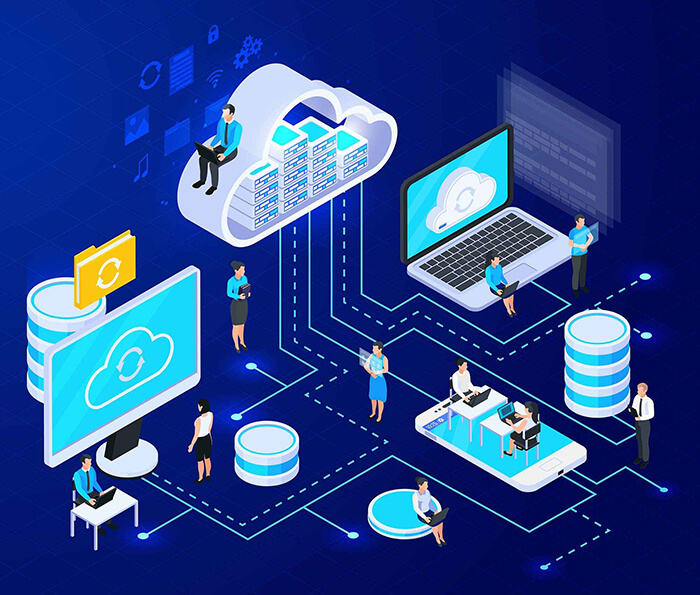Thank You!
A confirmation latter has been sent to your email. Check your inbox.


A remarkable paradigm shift has revolutionised the technological landscape. Artificial intelligence (AI) and cloud computing are two cutting-edge technologies that have occupied the digital space and harmoniously blend like a symphony of innovation and efficiency. AI-powered cloud computing has shattered the impossibilities' boundaries by unlocking unprecedented data-driven insights, decision-making, and automation. From autonomous vehicles that navigate with precision to virtual assistants that anticipate our needs, AI has become the cornerstone of a digital revolution. Coupled with the colossal computing power of the cloud, AI has transcended conventional limitations, enabling businesses to transform their operations and revolutionise industries. Artificial intelligence and cloud computing are now collaborating to improve our lives and make it more simple and sublime. Amazon's Alexa, Siri, Google Home, and other digital assistants merge artificial intelligence and cloud computing to give the best experiences of both worlds. Moreover, artificial intelligence (AI) cloud computing consolidates machine learning technologies with cloud-based computing environments to allow intuitive, connected experiences. Thus, AI technologies are playing a significant role in cloud computing on a large scale, particularly in businesses, allowing organisations to have easy access, workflow, storage, and sharing of data while also maintaining privacy and reliability, reducing cost and energy.
AWS is one of the leading providers of cloud services. They offer storage, databases, analytics, and more. Recently, AWS has been using AI to improve its recommended engine and detect anomalies in its data centre operations.
GCP is another leading provider of cloud services in the digital market, including storage, databases, analytics, and more. Google has used AI for many years and continues to use it in its cloud offerings. For example, they use machine learning to power their search engine and improve their predictions in Google Cloud Functions.
Azure is Microsoft’s cloud computing platform. It offers a variety of services like AWS and GCP. They utilise machine learning in Azure Cognitive Services to provide features such as text analysis and image recognition.
This is another notable example of how AI can transform cloud computing by providing cognitive services such as language translation and image recognition at large scales. IBM's integrated hybrid environment provides flexible data science tools to build and train AI models and prepare and analyse data. It is an all-in-one platform that enables to construct various data solutions with cutting-edge AI technologies and an easy-to-use user interface.
Financial crime prevention solutions provider Resistant AI has partnered with Google Cloud Marketplace to offer digital document authentication services. Under the partnership, Resistant AI’s Document Forensics solution became available on the Google Cloud Marketplace. This solution enables businesses to automate customer approvals and rejections more effectively during the onboarding process, spend less time manually examining documentation, and recognise and stop repeated fraud attempts. In addition, it analyses digital documents for anomalies using more than 500 machine-learning detectors.
NVIDIA enables GPU-accelerated AI computing platforms for cloud-based machine learning and deep learning applications, such as NVIDIA GPU Cloud (NGC) for GPU-optimized software containers and NVIDIA A100 Tensor Core GPUs for high-performance AI workloads. In addition, it offers performance, efficiency, and responsiveness critical to powering the next generation of AI inference in the cloud.
The ability to harness the immense computing power of the cloud merged with the cognitive capabilities of AI has scooped out new possibilities for innovation and disruption in not only technology companies but various other fields such as healthcare, finance, transportation, and more. It has profoundly impacted redefining the digital world from predictive analytics and personalised recommendations to autonomous vehicles and intelligent virtual assistants, setting the stage for a future where smart, data-driven solutions will be the new quality standards in the digital realm.
In addition, connecting an AI to a cloud has various benefits for both sides. Cloud servers hold a lot of data, which is an invaluable resource to any AI, but if more AIs are connected, they can learn from each other’s mistakes. When one particular AI learns a process, it can quickly transfer the knowledge to other AIs, drastically maximising the potential of such reciprocity. Heading back to when AI’s growth was hindered due to limited datasets, it could not analyse all the real-time data. Because Big data is the fuel that powers AI, and the advancement of big data analytics removed these obstacles. Tools that allow rapid analysis and technology have been formulated, making it agile enough to access colossal datasets.
Due to the cloud’s scalability, AI services provided from the cloud are also becoming scalable. Hence, when an enterprise wants to expand AI concerning projects, the cloud permits adding computing power or requesting more hours of the total capacity of servers from the providers. Migration of the services to the cloud dramatically reduces the costs of any organisation. Servers and additional required equipment are costly, especially for large-scale operations. e implementation of the cloud removes the need for server management and reduces maintenance costs. Productivity and efficiency bene ts are paramount when considering all the advantages the cloud offers.

We have entered a new digital era where the interest in cloud computing continues to rise, and many companies have already moved their IT into the cloud. The strategic implication of this is to improve current cloud technologies in rendering digital solutions that companies and businesses seek for growth and advancement. Developments in artificial intelligence opened new possibilities as cloud computing accelerates the pace of innovation by providing access to state-of-the-art AI tools, frameworks, and libraries. This empowers businesses to rapidly develop and deploy AI-powered applications without investing in expensive infrastructure, reducing time-to-market for new products and services. Therefore, the future of AI in cloud computing is shrouded in potential but fraught with uncertainty. However, despite the many mysteries to unfold, multiple factors are already justifying AI’s significant role and contribution to cloud computing and have proven this combination a winner so far.

In this era of technological innovation, a groundbreaking trend has emerged that promises limitless possibilities and beats the boundaries of human imagination. This progressive fusion of AI-driven cloud computing has opened up new dimensions of technological advancement. With the power of AI, cloud computing has reached new heights, unleashing possibilities that were once deemed unattainable. Imagination now takes centre stage as the only constraint in this revolutionary domain, where the convergence of intelligent algorithms and the vast computational capabilities of the cloud combine to create a world of infinite potential. It is paving the path toward revolutionising economies and redefining how we interact with technology. Undoubtedly, technological innovations like this are propelling humanity into a future where innovation knows no bounds, and the only limit is the extent of our imagination.
The convergence of artificial intelligence in cloud computing is redefining how businesses operate, innovate, and scale. From predictive analytics in cloud infrastructure to intelligent automation of workflows, AI-powered cloud computing offers unmatched agility and efficiency. Organizations can now tap into AI-enabled data management, optimize performance, and enhance security—all within highly scalable environments. As the digital world evolves, embracing smart cloud solutions will be critical for any enterprise looking to stay ahead in a rapidly shifting technological landscape.
Our expertise spans a diverse and proven tech stack, carefully employed to build solutions that meet evolving business needs with precision and reliability.
BACK END
FRONT END
CONTAINERIZATION
AUTOMATION
CI/CD TOOLS
MONITORING
PROGRAMMING LANGUAGES
FRAMEWORKS
LIBRARIES
CLOUD SERVICES